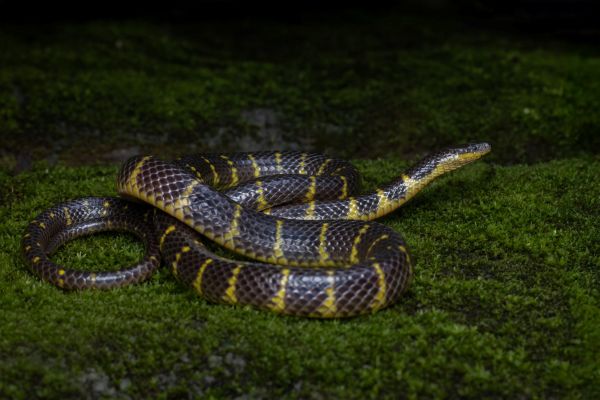India’s snakes changing range due to climate change
Many NE states, including Assam and Manipur, are projected to show increased risk of snakebites

Climate change could lead to shifts in the geographic distribution of certain snakes in India and an increase in the risk of snakebites in certain regions, a new modelling study concludes. The research, conducted by a team of Indian and South Korean scientists and published in PLOS Neglected Tropical Diseases, particularly looked at the four clinically important species of snakes, referred to as the Big Four, found in the Indian sub-continent.
India records the highest number of snakebite fatalities worldwide, between 46,000-60,000 annually. Climate change is anticipated to significantly impact the distribution of snakes, leading to notable shifts in their habitats towards human-dominated landscapes, the report says. This may potentially increase the incidence of bites from the Big Four species — common krait (Bungarus caeruleus), Russels’ viper (Daboia russelii), saw-scaled viper (Echis carinatus), and Indian cobra (Naja naja) — and a notable human-health risk that has not yet been assessed in India, the report says.
Future snakebite scenarios
The study focused on the potential risk of snakebites from the Big Four species rather than directly assessing their population status. At present, several districts in Karnataka, such as Chikkaballapura, Haveri, and Chitradurga, and Gujarat (Devbhumi Dwarka and Jamnagar) have emerged as high-priority areas. Under future scenarios, however, many northern and northeastern states are projected to show an increased risk of snakebites, including Assam (Nagaon, Morigaon, and Golaghat districts), Manipur (Tengnoupal district), and Rajasthan (Pratapgarh district).
The scientists used the risk index, a way of estimating likely and severe snakebite risks in different regions. The index combines three main factors: how much does snake habitat overlap with croplands and built-up areas, since these are places where people and snakes are most likely to come into contact; the socioeconomic vulnerability of the region, which reflects how well or poorly a community can cope with snakebite incidents; and (iii) the availability of healthcare facilities, which directly influences how effectively snakebites can be treated. The risk index reflects how strongly people and snakes interact, how vulnerable the regions are, and how much healthcare access they have, with higher values pointing to greater snakebite risk.
The ecosystem is what finally decides the distribution of snakes, prey and what the prey depend on, says Jaideep Menon, from the department of adult cardiology and public health, Amrita Institute of Medical Sciences, Kochi, who was not a part of the study. He and his team had advocated for a One Health approach to venomous snakebites, in a recent paper in One Health Outlook.
Climate change and public health
The authors of the latest paper say that this is “the first study in India to integrate climate-based species distribution models with socioeconomic vulnerability and healthcare capacity”. Their findings show that “climate change is not just an environmental crisis but it’s also a looming public health crisis”.
“The initial motivation came from realising that India records the highest number of snakebite cases globally. As we began reviewing the literature, we found that most studies focused directly on snakebite incidents, whereas our primary area of work, i.e., spatial ecology, was scarcely represented. This gap became our starting point,” one of the authors, Shantanu Kundu, informs Mongabay India. Kundu is the assistant professor at the Ocean and Fisheries Development International Cooperation Institute, College of Fisheries Science, Pukyong National University, Busan.
The Big Four species of snakes, which account for the majority of snakebites, often occur in agricultural fields or households. Kundu says that socioeconomic deprivation, along with limitations in healthcare infrastructure and access, plays a critical role in snakebite mortality and morbidity. Understanding how these snakes might shift their distribution under climate change, and the consequences of the shift is essential not only for reducing snakebite incidents and mitigating human–snake interactions but also for providing guidance for species conservation, he says.
The changing weather patterns and how that affects the biosphere or ecosystem of flora and fauna would have a bearing on the number of snakes and species, says Menon. The presence of snakes is also dependent on the presence of prey, which also needs to be factored across the food-chain, he points out.
If dry arid areas transform with more greenery, it is likely there will be a change in dominant species, with more numbers of Russell’s viper and fewer saw-scaled vipers. Similarly, natural calamities such as landslips, floods and earthquakes have been observed to result in an increase in snake-human interactions. How change in agricultural practices — for example switching from grains to other crops, or the use of combined harvesters — would also have a bearing on the number of snake-human conflicts,” says Menon.
The new research adds to recent published reports on the rise in snakebites in tropical regions. A separate report by the World Health Organization (WHO) says that “many deadly snake species are predicted to increase in abundance and come into contact with more people”.
Similarly a 2024 report in the Lancet Planetary Health cautions that the combination of an increase in climatically suitable areas and socioeconomic factors (including low-income and high rural populations) means that southeast Asia and Africa (and countries including Uganda, Kenya, Bangladesh, India, and Thailand in particular) could have increased vulnerability to snakebites in the future, with potential effects on public human and veterinary health.
In 2021, a report in Toxicon cautioned that distribution and abundance of snakes are expected to be affected by climate change. Land-use change may also impact snakes but at smaller spatial scales than climate. Human populations could experience novel patterns and morbidity of snakebite. Reducing snakebite should be accompanied by actions that protect snake diversity.
Addressing multiple gaps
In recent years, India has made notable progress with improved healthcare access and better availability of antivenoms, says Kundu. However, it remains essential to extend these services to remote and underserved areas.
“Equally important is promoting basic knowledge and widespread awareness about snakes through community education focused on identification, dispelling superstitions, and emphasising the need for immediate medical care at the nearest healthcare facility in the event of a snakebite,” he says.
Training individuals as snake rescuers is also crucial, particularly in fringe areas. “Such rescuers must not treat the activity as public display or entertainment, as this can send a negative message and have serious consequences,” cautions Kundu. He adds that training selected individuals to coordinate between communities and healthcare providers, especially when victims’ families may not know the appropriate steps to take, can ensure timely treatment and significantly reduce mortality.
Several cases have shown that with prompt treatment, particularly for bites from the Big Four species, patients can recover without severe complications. This underscores the need for greater awareness about seeking immediate care, alongside ensuring a consistent supply of antivenoms and adequately trained healthcare personnel.
At the community level, people should be encouraged not to harm or disturb snakes but to inform the forest department or relevant authorities for safe rescue and relocation, says Kundu. Collectively, such measures could substantially reduce snakebite-related mortality and morbidity.
Menon notes that while there has been significant investment in research and mitigation of snakebites in India, both in evidence generation and policy, through the National Action Plan for Prevention and Control of Snakebite Envenoming (NAP-SE), launched in March 2024 to halve snakebite deaths by 2030, persistent challenges remain. “The old pitfalls still stand. Fear of adverse reactions often prevents primary healthcare doctors from administering anti-snake venom,” he says.
He adds that alternate healers, lack of awareness, faulty first-aid practices, behavioural habits, poor infrastructure, weak health systems, geographical variability in venom, and species beyond the Big Four continue to drive mortality and morbidity.
Menon recommends assessing the impact of climate change on snake populations, movement, behaviour, and prey; planning anti-snake venom stocks accordingly; and strengthening health systems based on hotspot mapping. “Real-time dashboards of snake sightings, rescues, and bite incidents would also greatly facilitate the mapping process,” he says.





